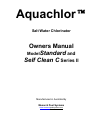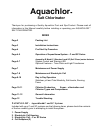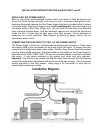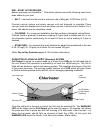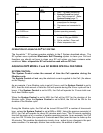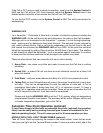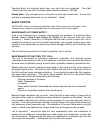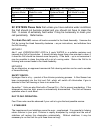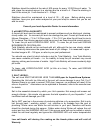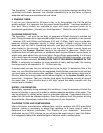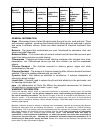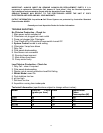9
Stabiliser should be added at the rate of 500 grams for every 10,000 litres of water. To
add, place the required amount in a stocking and tie a brick to it. Place the stocking in
front of the return jet. It will dissolve in 2 – 3 days.
Stabiliser should be maintained at a level of 30 – 50 ppm. Before adding more
stabiliser, have your pool water analysed at your pool shop to ensure that you do not
add too much.
Consult your local Aquachlor Dealer for more information.
2. pH AND TOTAL ALKALINITY:
A correct pH level must be maintained to prevent problems such as black spot, staining,
cloudy water, etc. An incorrect pH level can damage the pool. Correct pH levels are as
follows; Fibreglass – 7.0 to 7.4 Other pools – 7.2 to 7.6 If you allow the pH level to rise to
8.0 or above, the chlorine required could be as much as three times the normal amount.
To lower the pH add HYDROCHLORIC ACID. To raise the pH level add SODIUM
BICARBONATE OR SODA ASH.
Total Alkalinity should not be confused with pH, although the two are closely related.
Total Alkalinity determines the speed and ease of pH change. It is measured in ppm –
the ideal range is 80 – 150 ppm, or refer to your pool professional.
You should use a test kit which includes a test for Total Alkalinity. Low Total Alkalinity
can cause unstable pH levels – i.e. An inability to keep the pH constant may cause
staining, etching and corrosion of metals. High Total Alkalinity will cause constantly high
pH levels.
To lower, add HYDROCHLORIC ACID (a little at a time). To raise, add SODIUM
BICARBONATE.
3. SALT LEVELS:
The salt level MUST NEVER BE LESS THAN 4000 ppm for Aquachlor Systems.
Operating the Unit with too little salt in the pool will cause damage to your Cell. For C
Systems there is no need to exceed 7000 ppm, however, no problems will result if this
occurs. Aquachlor chlorinators can be operated in Seawater, refer to the manufacturer
for details.
Salt is the essential element by which your Unit operates. Not enough salt means not
enough chlorine - this simple rule governs the total operation of your Aquachlor, and
insufficient salt will damage your Cell.
Salt is NOT used up in the process of producing chlorine or by evaporation. Salt is only
lost through back - washing, splash - out, overflow or by leakage from the pool or
plumbing. Winter rains can dilute the salt solution in your pool; therefore salt levels
should be checked during this season. Colder water during Winter will reduce the unit
output and turn the WARNING LED red. If this occurs extra salt can be added or simply
check the salt level regularly and ignore the WARNING LED until water temperatures
rise.
Low salt levels will destroy the coating on the Anode plates and will void all
Warranty.



